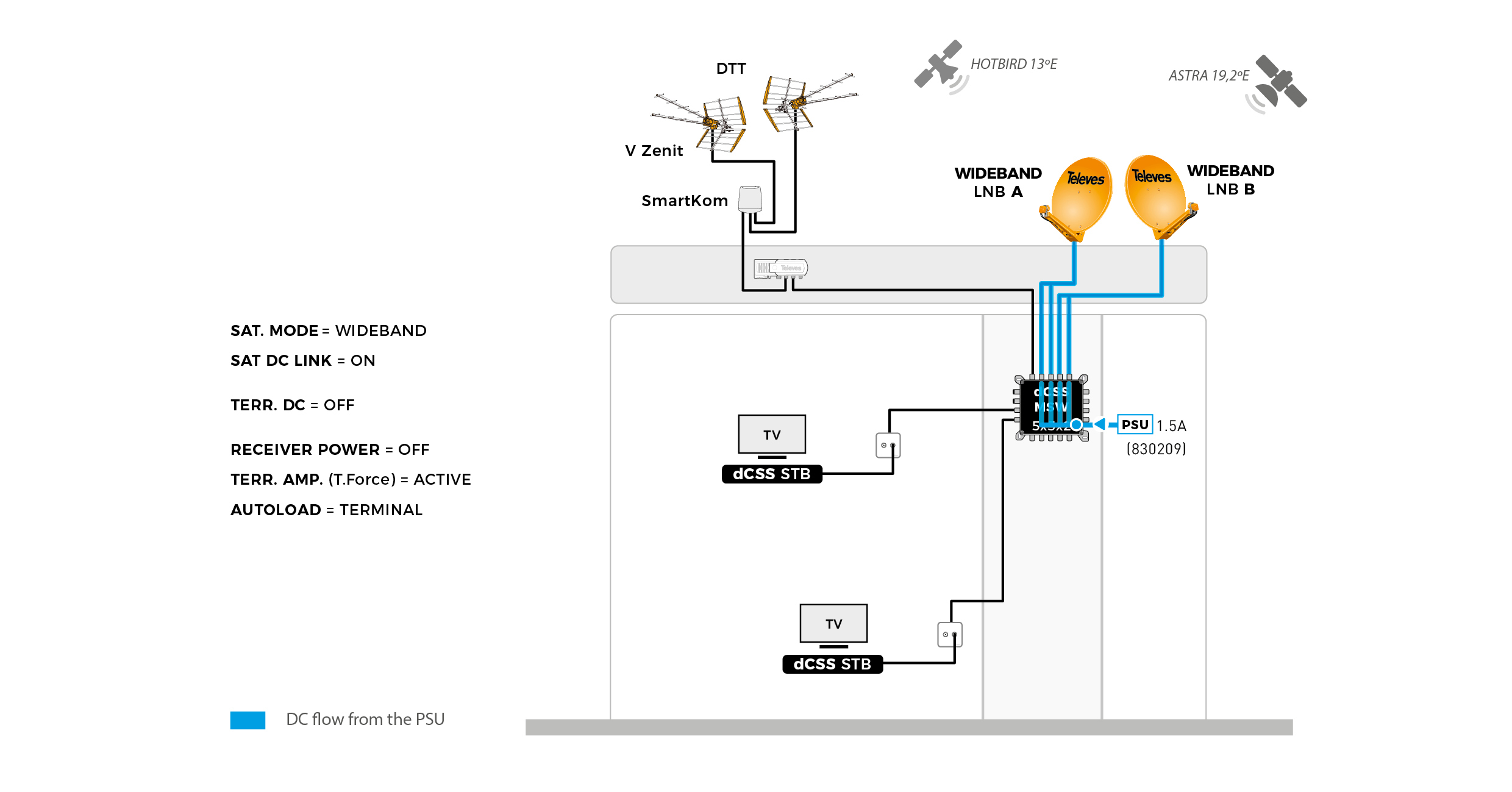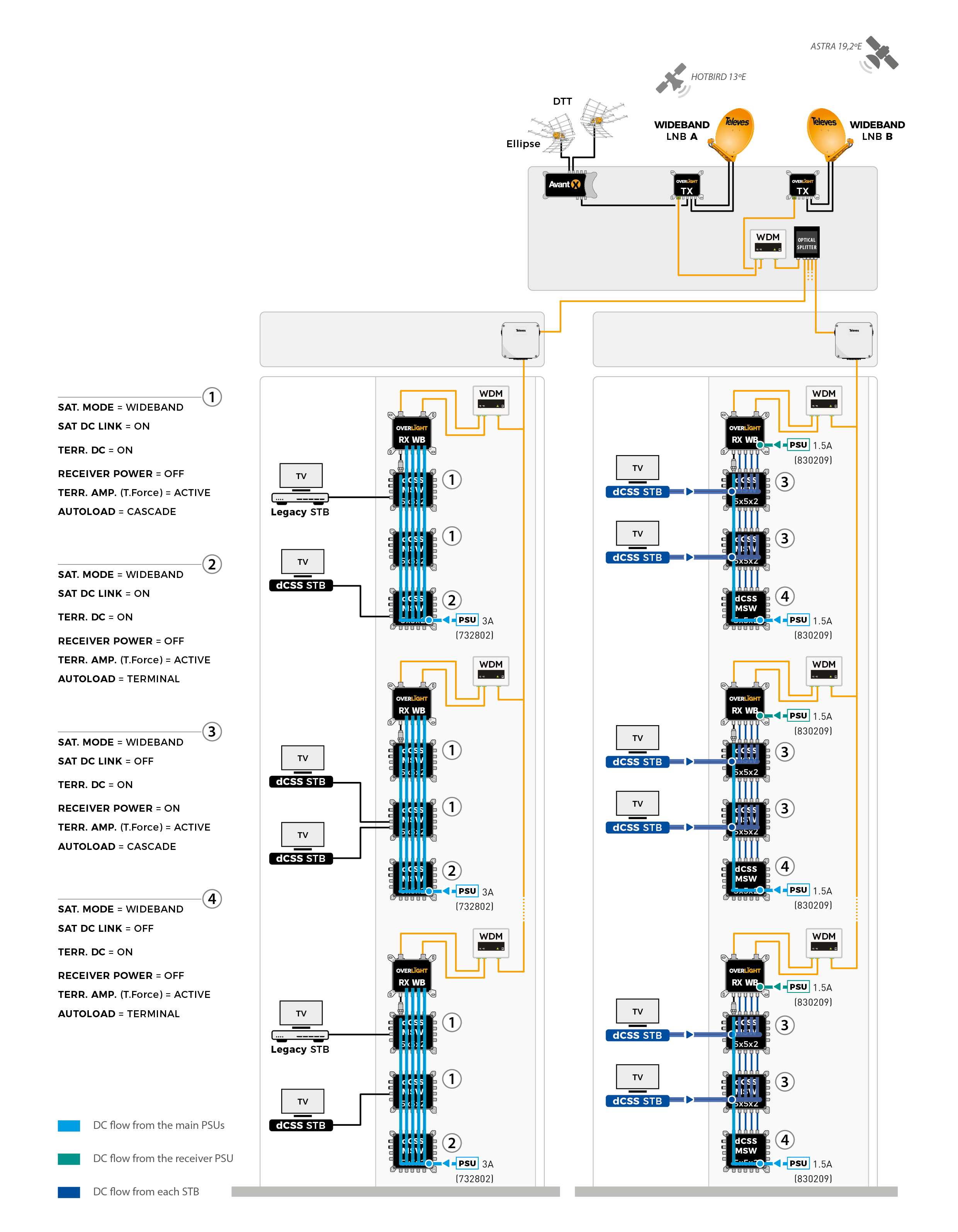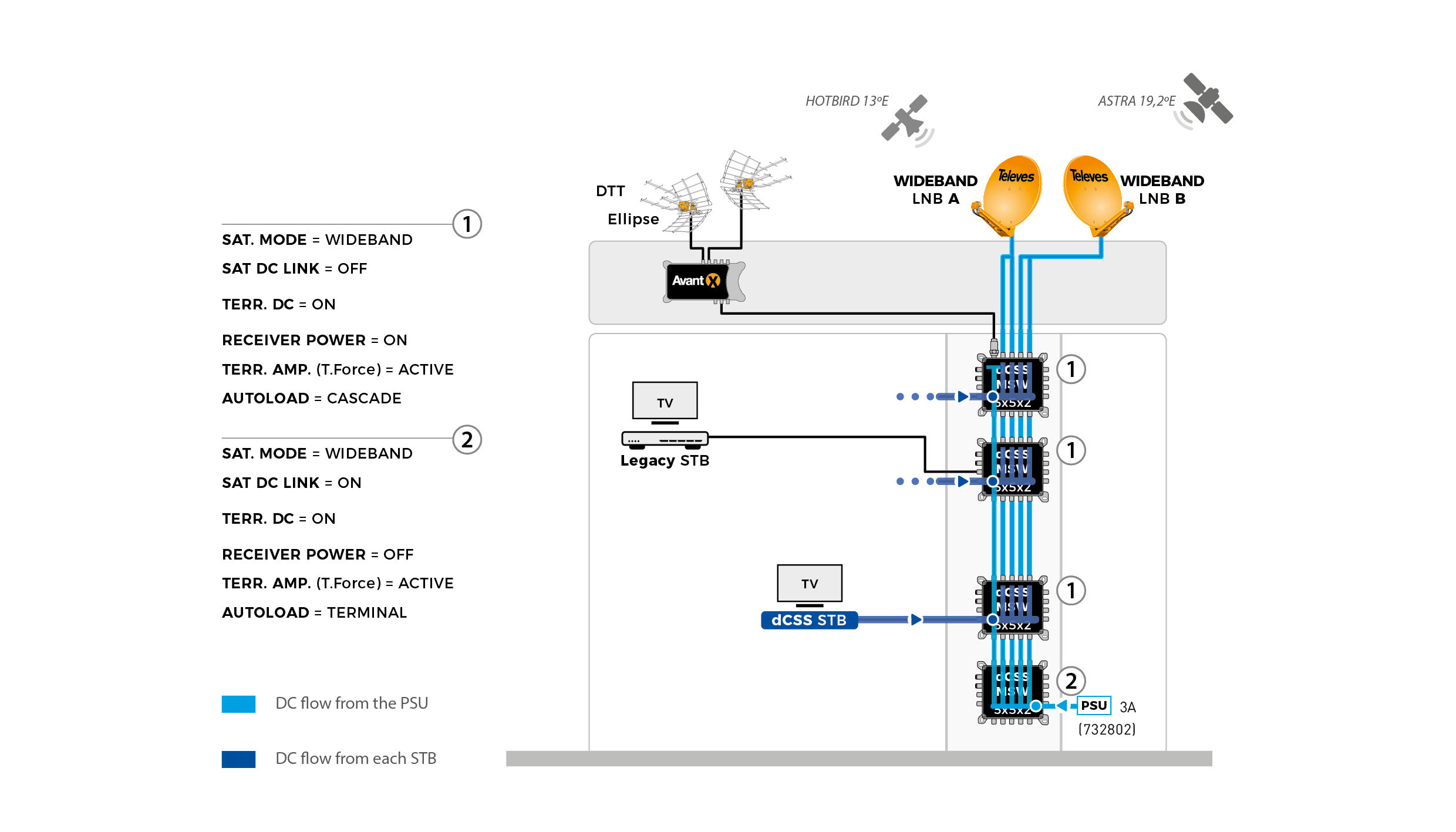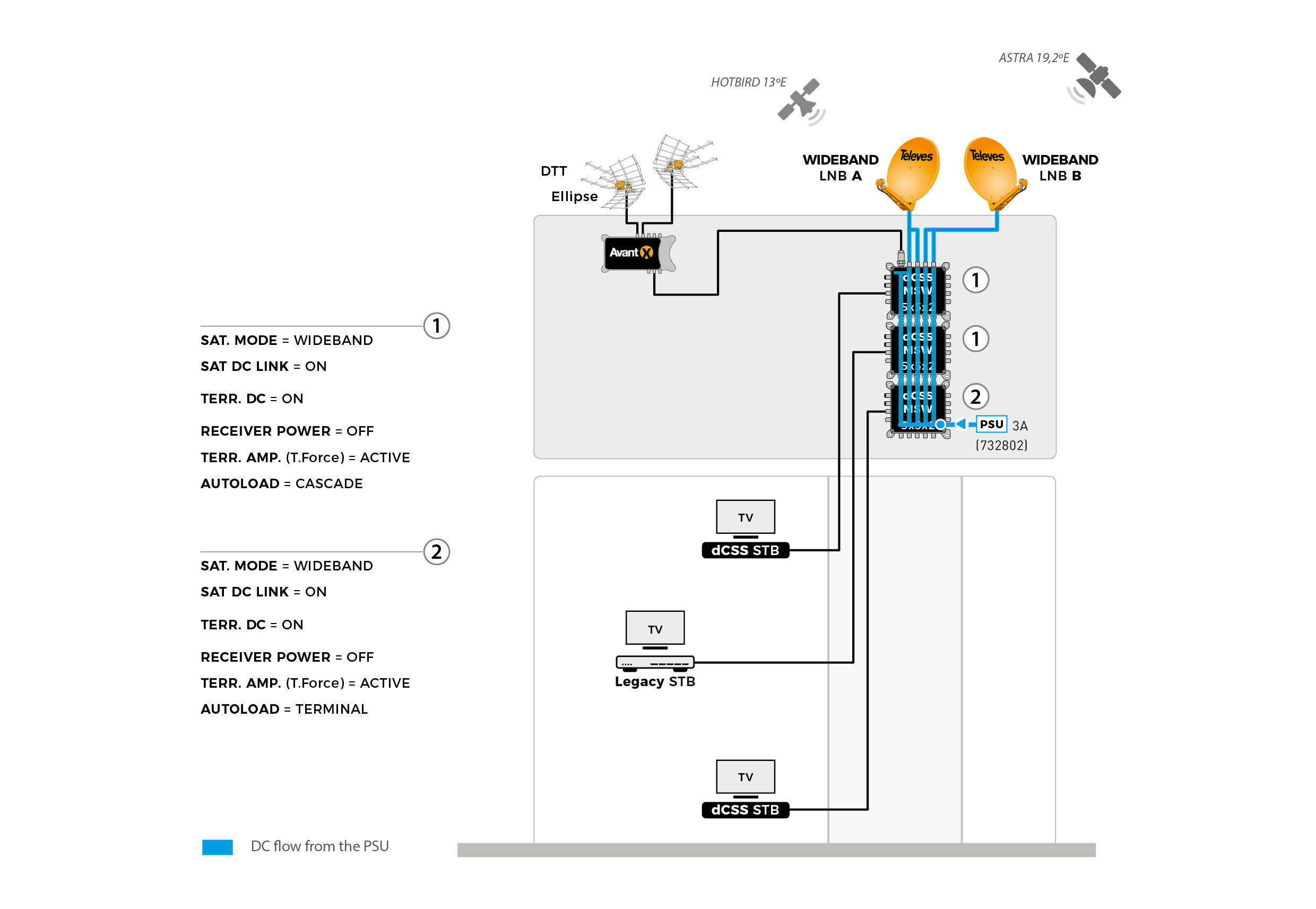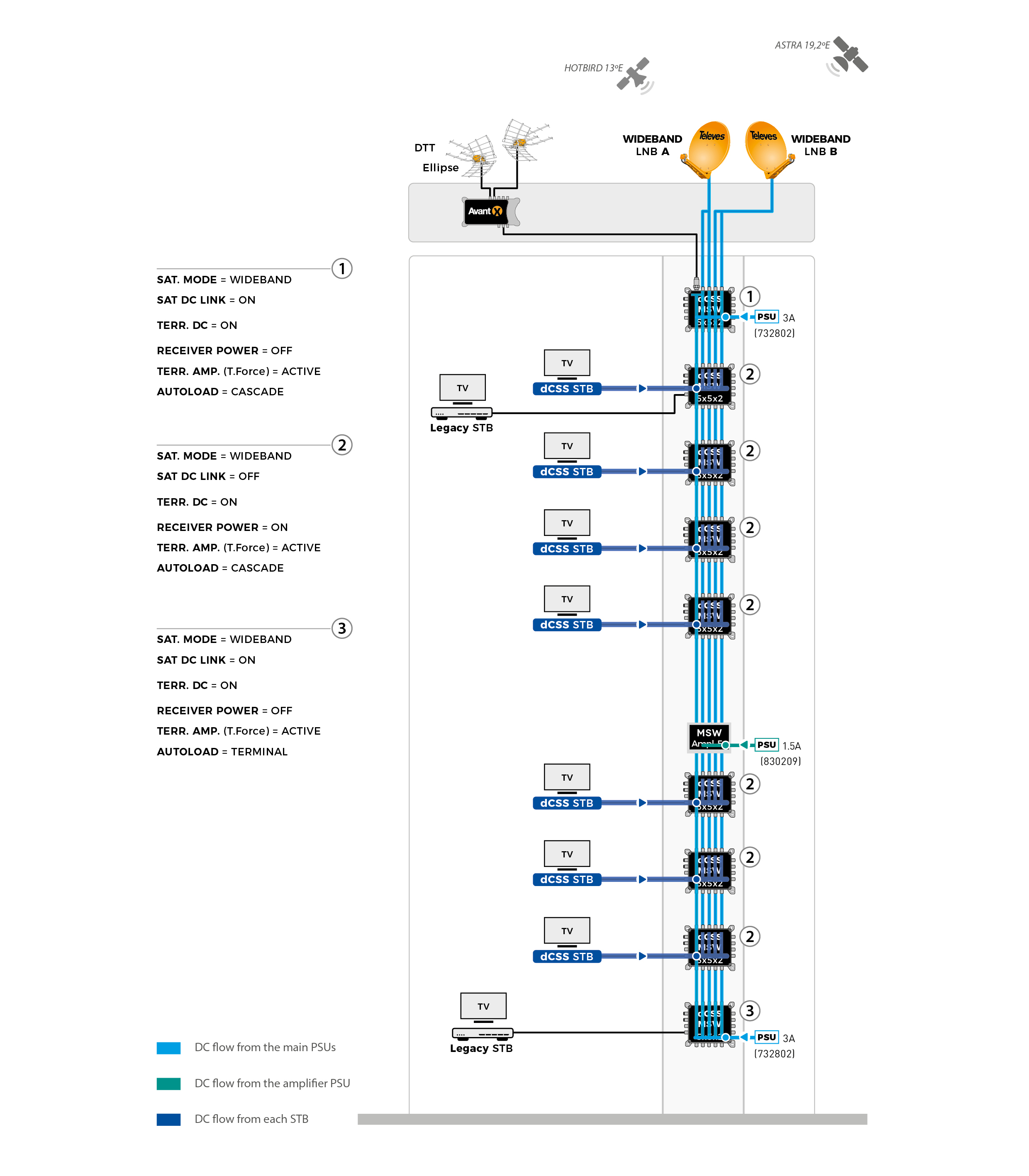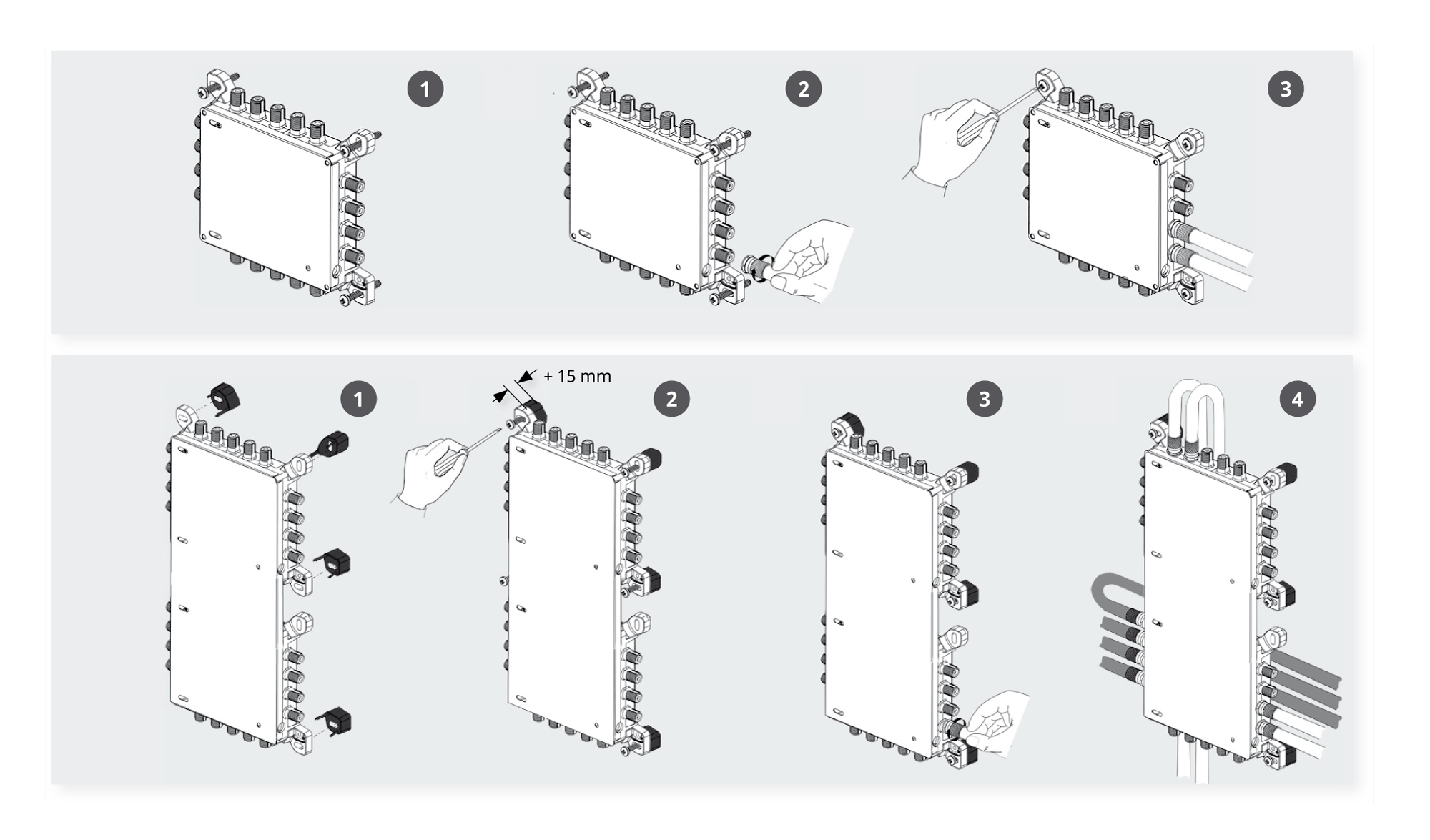dCSS NevoSwitch 5 inputs - 2 outputs, for 1 satellite (Quattro) or 2 satellites (WideBand), SKY version
Multiswitch equipped with 5 inputs (one passive terrestrial and four inputs for satellite) and 2 dCSS/dSCR user outputs that are compliant with SCR I (EN50494) and SCR II (EN 50607) and the Legacy mode, which makes it compatible with any new or existing set top boxes. The four satellite inputs can be selected in Quattro mode for reception of the polarities of 1 satellite, or in WideBand mode for reception of 2 satellites.
Can be used as a terminal (star topology) or as a cascade by using a simple switch. Furthermore, the exclusive DCFLEX functionality provides full flexibility to the multiswitch by allowing the equipment to be powered from anywhere in the system. The installer is free to choose the powering method for the multiswitch, to better adapt to the requirements of any given scenario. The versatility is provided by several control switches, but essentially by the capacity of the multiswitch to be isolated from the cascade (in terms of current) or not.
- 2 user outputs, with up to 16 user bands each
- Very compact
- High shielding (A class) thanks to its manufacture in Zamak
- Multiple powering options (DCFLEX functionality): From the power supply, from the receiver, or from the cascade through the satellite inputs or outputs
- Easy to integrate in an existing system: By switching the SAT DC LINK to OFF with the power supply connected, the MSW is locally powered (or through the STB) without adding nor taking power from the cascade
- Brings higher security to the set top boxes connected to the multiswitch, which can be fully isolated (RECEIVER POWER OFF) from the power supply in the cascade. If switched to ON, the MSW can be powered through the STB
- The TERR.DC switch isolates or connects the power supply available from the cascade in the terrestrial branch. Can be useful for the feeding of a mast amplifier or an intelligent antenna, but also for the terrestrial branches of other MSW in the cascade
- Wide voltage range: Voltages from 12 V to 18 V make it compatible with most existing systems
- ECO mode: Isolated from the cascade, the multiswitch can reduce power consumption down to zero, when the STBs are disconnected and the terrestrial passive
- Equipped with the TForce technology, the terrestrial output level is automatically adjusted (TERR. AMP. ACTIVE) to the optimal level
- Compatible with conventional multiswitches in the NevoSwitch series (in Quattro mode), and with other IRS systems
- Versatile: selector switch to shift between cascade and terminal modes
- Input and output colour identification
- 100% European design, quality, and manufacturing
What is dCSS technology?
dCSS technology is the evolution of the SCR technology, which characteristics are described below:
The SCR technology (Satellite Channel Router) allows full distribution of one or several satellite signals to multiple users over a single coaxial cable.
The relevant aspect here is the suppression of the multiple cables required to support the new reception devices; this is achieved by means of a static or dynamic user band assignment and the use of DiseQc commands for satellite signal tuning.
A historical note: the SCR standard (EN50494) was defined in 2007. Based on the analogue concept, this technology considered the use of up to 8 user bands (User Bands) in the satellite IF band (950 MHz-2150 MHz). Each band is assigned a user tuner, and on each any input band and polarity can be selected using frequency processing.
Later, the dCSS technology (Digital Channel Stacking Switch), based on the EN50607 standard, introduces significant improvements, such as the increase in the number of satellites to be distributed, or the possibility to use 32 user bands in a single cable, which is almost equivalent to occupying the whole satellite band. Furthermore, the dCSS technology is backwards compatible with SCR.
The dCSS technology can be used in multiple scenarios (individual and communal distribution), and in dynamic or static operation modes. The latter is the most flexible and inexpensive alternative to the headends with intermediate frequency processing that came along with early analogue and digital satellite distributions.
Likewise, the dCSS technology can be combined with optical fibre, which significantly extends the reach of the satellite distribution.
In short, the dCSS Technology is quite a step forward in the distribution of satellite signals over a single coaxial cable, and it will make for the mass introduction of the new reception devices in homes; devices such as Home Gateways or PVR, the big bet of satellite operators in the short and medium terms.
WideBand technology
WideBand (also known as FullBand) refers to broadband transmission technology that uses a wide range of frequencies. In WideBand TV systems, a substantial portion or the whole of the frequency spectrum is available to users. It can be used in fiber deployments where long cable runs are demanded, or coaxial scenarios in combination with multiswitches adapted to this technology.
In WideBand technology, an LNB captures a complete satellite signal and distributes it through 2 universal outputs (vertical -V- and horizontal -H-), each of them with the combination of high (H) and low (L) bands, in a frequency range between 290 and 2340 MHz.
Despite the fact that Quattro technology is the most widely deployed technology in TV systems nowadays, WideBand technology brings significant advantages to the installation:
- Simpler, faster and cleaner installation: In WideBand technology the number of coaxial cables connecting the LNB to the multiswitches is half as in traditional Quattro deployments, so the installation is done quicker and easier. The installation will also be tidier with fewer cables.
- Wider bandwidth than other technologies: WideBand channels can carry more information thanks to their wide bandwidth (290-2340MHz). This powerful feature allows a greater number of services to be delivered to the end users of the installation.
- Reusable deployment: WideBand technology allows signal distribution by reusing a Quattro installation. It can be distributed through the old 4 cables coming down from the roof to capture signals from up to 2 satellites, changing only LNBs and MSWs to be WideBand compatible.
| Number of inputs | 5 | |||
|---|---|---|---|---|
| Number of cascadable outputs | 5 | |||
| Number of user outputs | 2 | |||
| Frequency range TERR. | MHz | 47 ... 862 | ||
| Satellite mode |
| |||
| Frequency range SAT. | MHz |
| ||
| Input level TERR Active | dBµV | 75 ... 100 | ||
| Input level TERR Passive | dBµV | 65 ... 110 | ||
| Input level SAT. | dBµV | 60 ... 97 | ||
| Through losses TERR. | dB | < 2.5 | ||
| Through losses SAT. | dB | 2 | ||
| Cross-polarity isolation | dB | > 30 | ||
| Output modes dCSS | Legacy / SCR I / SCR II | |||
| dCSS standard | Sky (EN50494/EN50607) | |||
| User Band bandwidth | MHz | 46 | ||
| User Bands (UB) per user | 16 | |||
| Output level SAT | dBµV | 84 | ||
| Output level 2CH DBV-T | dBµV | 88 | ||
| Gain TERR Active | dB | 12 ... 15 | ||
| Attenuation TERR Passive | dB | -16 | ||
| Automatic gain range TERR. Active | dB | 25 | ||
| Overall DC Power options MSW dCSS | PWR port / dCSS out (Receiver power ON) / Trunk lines VL/VH/HL/HH | |||
| Powering | Vdc | 12 ... 18 | ||
| Current consumption | A | 3 | ||
| Max current (@12V): dCSS + Terr. Amp. + Auto load | mA | 425 | ||
| Max current (@18V): dCSS + Terr. Amp. + Auto load | mA | 300 | ||
| User output max current | mA | 800 | ||
| Max current per trunk line | mA | 750 | ||
| Total max. current SAT trunk lines | A | 3 | ||
| Operating temperature | °C | -5 ... 45 | ||
| Protection index (IP) | 20 |
Physical data
Net weight: 400 g
Gross weight: 470 g
Width: 137 mm
Height: 121 mm
Depth: 45 mm
Main product weight: 400 g
Packing
Box 1 Units
| tlv_discontinued | No | |||||||||||||||||||||||||||||||||||||||||||||||||||||||||||||||||||||||||||||||||||||||||||||||||
|---|---|---|---|---|---|---|---|---|---|---|---|---|---|---|---|---|---|---|---|---|---|---|---|---|---|---|---|---|---|---|---|---|---|---|---|---|---|---|---|---|---|---|---|---|---|---|---|---|---|---|---|---|---|---|---|---|---|---|---|---|---|---|---|---|---|---|---|---|---|---|---|---|---|---|---|---|---|---|---|---|---|---|---|---|---|---|---|---|---|---|---|---|---|---|---|---|---|---|
| tlv_tags | What is dCSS technology?
dCSS technology is the evolution of the SCR technology, which characteristics are described below: The SCR technology (Satellite Channel Router) allows full distribution of one or several satellite signals to multiple users over a single coaxial cable. WideBand technologyWideBand (also known as FullBand) refers to broadband transmission technology that uses a wide range of frequencies. In WideBand TV systems, a substantial portion or the whole of the frequency spectrum is available to users. It can be used in fiber deployments where long cable runs are demanded, or coaxial scenarios in combination with multiswitches adapted to this technology. In WideBand technology, an LNB captures a complete satellite signal and distributes it through 2 universal outputs (vertical -V- and horizontal -H-), each of them with the combination of high (H) and low (L) bands, in a frequency range between 290 and 2340 MHz. Despite the fact that Quattro technology is the most widely deployed technology in TV systems nowadays, WideBand technology brings significant advantages to the installation:
|
|||||||||||||||||||||||||||||||||||||||||||||||||||||||||||||||||||||||||||||||||||||||||||||||||
| tlv_tabla_especificaciones |
|
|||||||||||||||||||||||||||||||||||||||||||||||||||||||||||||||||||||||||||||||||||||||||||||||||
| tlv_ean | 8424450297827 | |||||||||||||||||||||||||||||||||||||||||||||||||||||||||||||||||||||||||||||||||||||||||||||||||
| tlv_dim_product_x | 137 | |||||||||||||||||||||||||||||||||||||||||||||||||||||||||||||||||||||||||||||||||||||||||||||||||
| tlv_dim_product_x_label | Width | |||||||||||||||||||||||||||||||||||||||||||||||||||||||||||||||||||||||||||||||||||||||||||||||||
| tlv_dim_product_x_unit | mm | |||||||||||||||||||||||||||||||||||||||||||||||||||||||||||||||||||||||||||||||||||||||||||||||||
| tlv_dim_product_y | 121 | |||||||||||||||||||||||||||||||||||||||||||||||||||||||||||||||||||||||||||||||||||||||||||||||||
| tlv_dim_product_y_label | Height | |||||||||||||||||||||||||||||||||||||||||||||||||||||||||||||||||||||||||||||||||||||||||||||||||
| tlv_dim_product_y_unit | mm | |||||||||||||||||||||||||||||||||||||||||||||||||||||||||||||||||||||||||||||||||||||||||||||||||
| tlv_dim_product_z | 45 | |||||||||||||||||||||||||||||||||||||||||||||||||||||||||||||||||||||||||||||||||||||||||||||||||
| tlv_dim_product_z_label | Depth | |||||||||||||||||||||||||||||||||||||||||||||||||||||||||||||||||||||||||||||||||||||||||||||||||
| tlv_dim_product_z_unit | mm | |||||||||||||||||||||||||||||||||||||||||||||||||||||||||||||||||||||||||||||||||||||||||||||||||
| tlv_weight_product_label | Main product weight | |||||||||||||||||||||||||||||||||||||||||||||||||||||||||||||||||||||||||||||||||||||||||||||||||
| tlv_weight_product | 400 | |||||||||||||||||||||||||||||||||||||||||||||||||||||||||||||||||||||||||||||||||||||||||||||||||
| tlv_weight_product_unit | g | |||||||||||||||||||||||||||||||||||||||||||||||||||||||||||||||||||||||||||||||||||||||||||||||||
| tlv_gross_weight_label | Gross weight | |||||||||||||||||||||||||||||||||||||||||||||||||||||||||||||||||||||||||||||||||||||||||||||||||
| tlv_gross_weight | 470 | |||||||||||||||||||||||||||||||||||||||||||||||||||||||||||||||||||||||||||||||||||||||||||||||||
| tlv_gross_weight_unit | g | |||||||||||||||||||||||||||||||||||||||||||||||||||||||||||||||||||||||||||||||||||||||||||||||||
| tlv_net_weight_label | Net weight | |||||||||||||||||||||||||||||||||||||||||||||||||||||||||||||||||||||||||||||||||||||||||||||||||
| tlv_net_weight_unit | g | |||||||||||||||||||||||||||||||||||||||||||||||||||||||||||||||||||||||||||||||||||||||||||||||||
| tlv_net_weight | 400 | |||||||||||||||||||||||||||||||||||||||||||||||||||||||||||||||||||||||||||||||||||||||||||||||||
| tlv_1_type_pack | Box | |||||||||||||||||||||||||||||||||||||||||||||||||||||||||||||||||||||||||||||||||||||||||||||||||
| tlv_1_type_pcs_pack | Units | |||||||||||||||||||||||||||||||||||||||||||||||||||||||||||||||||||||||||||||||||||||||||||||||||
| tlv_1_pcs_pack | 1 |
1) Powering from PSU
Switches: TERR.DC – OFF, RECEIVER POWER – OFF, SAT DC LINK – OFF
- NO, powering is not supplied from the STB receivers / RECEIVER POWER = OFF/
- NO, the satellite (V-LOW, H-LOW, V-HIGH, H-HIGH) trunk is not supplied / SAT DC LINK = OFF/
- NO, the terrestrial (TERR.) trunk is not supplied/ TERR.DC = OFF/
Switches: TERR.DC - OFF, RECEIVER POWER – OFF, SAT DC LINK – ON
- NO, powering is not supplied from the STB receivers/ RECEIVER POWER = OFF/
- YES, the satellite trunk is supplied (V-LOW, H-LOW, V-HIGH, H-HIGH) /SAT DC LINK = ON/
- NO, the terrestrial (TERR.) trunk is not supplied /TERR.DC = OFF/
Switches: TERR.DC - ON, RECEIVER POWER – OFF, SAT DC LINK – ON
- NO, powering is not supplied from the STB receivers /RECEIVER POWER = OFF/
- YES, the satellite (V-LOW, H-LOW, V-HIGH, H-HIGH) trunk is supplied /SAT DC LINK = ON/
- YES, the terrestrial (TERR.) trunk is supplied thaks to the power supply/TERR.DC = ON/
2) Powering from the User STB receiver
Switches: TERR.DC - OFF, RECEIVER POWER – ON, SAT DC LINK – OFF
- YES, powering is supplied from the STB receivers /RECEIVER POWER = ON/
- NO, the satellite trunk is not supplied (V-LOW, H-LOW, V-HIGH, H-HIGH) /SAT DC LINK = OFF/
- NO, the terrestrial (TERR.) trunk is not supplied /TERR.DC = OFF/
Switches: TERR.DC - OFF, RECEIVER POWER – ON, SAT DC LINK – ON
- YES, powering is supplied from the STB receivers /RECEIVER POWER = ON/
- YES, the satellite trunk is supplied (V-LOW, H-LOW, V-HIGH, H-HIGH) /SAT DC LINK = ON/
- NO, the terrestrial (TERR.) trunk is not supplied /TERR.DC = OFF/
3) Powering from the satellite trunk (V-LOW, H-LOW, V-HIGH, H-HIGH)
Switches: TERR.DC – OFF, RECEIVER POWER – OFF, SAT DC LINK – ON
- NO, powering is not supplied from the STB receivers /RECEIVER POWER = OFF/
- NO, the satellite trunk is not supplied but YES powering is supplied from the trunk /SAT DC LINK = ON/
- NO, the terrestrial (TERR.) trunk is not supplied /TERR.DC = OFF/
-
AutoCAD drawing
719301_CAD09230007.dwg
(1.41 MB) -
Product release brochure
BRO_NevoSwitch_dCSS_Quattro-WB_EN_PLA07240011.pdf
(1.93 MB) -
Technical specifications
technical_specifications_en_US_TEC02240005_719301.pdf
(0.11 MB) -
Product Sheet
719301_en_US_product_sheet_PSH03240035_719301.pdf
(0.5 MB) -
User Manual
MUS11230000_000_ES-EN-IT-DE-ENUS_719301.pdf
(3.41 MB) -
User Manual
MUS07240000_000_ES-IT-DE-ENUS_719301_719302_719311_719312.pdf
(3.11 MB) -
End-User License Agreement
EULA11240003_PDF - English_719301_719302_719311_719312.pdf
(0.05 MB)









